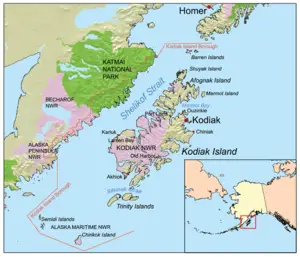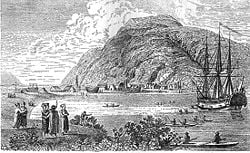Kodiak Island
Kodiak Island is a large island on the south coast of the U.S. state of Alaska, separated from the Alaska mainland by the Shelikof Strait. It is the largest island in the Kodiak Archipelago and at 8975 km² (3465 squares mile) in area is the largest island in Alaska and the second-largest island in the United States (after the Big Island of Hawaii). It is 160 km (100 miles) long and in width ranges from 16 to 96 km (10 to 60 miles).
Kodiak Island is mountainous and heavily forested in the north and east, but fairly treeless on the south. The island has many ice-free, deep bays that provide sheltered anchorages for boats. The southwestern two-thirds of the island, like much of the Kodiak Archipelago, is part of Kodiak National Wildlife Refuge.
Kodiak Island is part of the Kodiak Island Borough of Alaska. The largest town on the island is Kodiak. Other settlements include the villages of Akhiok, Old Harbor, Karluk, Larsen Bay, Port Lions, and Ouzinki. Kodiak is also home to a large Coast Guard station, Integrated Support Command Kodiak.
The Kodiak Bear and the king crab are native to the island. The fishing industry is the most important economic activity on the island; fisheries include Pacific salmon, Pacific halibut, and crab. The Karluk River is famous for its salmon run. Logging, ranching, numerous canneries, and some copper mining are also prevalent.
History
Kodiak is the ancestral land of the Koniaga, an Alutiiq nation of Alaska Natives. The original inhabitants subsisted by hunting, fishing, farming, and gathering. The first outsiders to settle on the island were Russian explorers under Grigory Shelikhov, who founded a Russian settlement on Kodiak Island at Three Saints Bay near the present-day village of Old Harbor in 1784. Following the 1867 Alaska purchase the island became part of the United States; Americans settled there and engaged in hunting and fox farming.
The Koniagas had been studied by European explorers, who marveled at their practice of male concubinage: "A Kodiak mother will select her handsomest and most promising boy, and dress and rear him as a girl, teaching him only domestic duties, keeping him at women's work, associating him with women and girls, in order to render his effeminacy complete. Arriving at the age of ten or fifteen years, he is married to some wealthy man who regards such a companion as a great acquisition. These male concubines are called Achnutschik or Schopans'" (Richard Francis Burton in his Terminal Essay, after Holmberg, Langsdorff, Joseph Billings, Choris, Yuri Lisiansky and Marchand)
Kodiak Island was explored in 1763 by Russian fur trader Stepan Glotov. The island was the location of the first permanent Russian settlement in Alaska, founded by Grigory Shelikhov, a fur trader, on Three Saints Bay in 1784. The settlement was moved to the site of present-day Kodiak in 1792 and became the center of Russian fur trading. In 1912 the eruption of Novarupta on the mainland (erroneously attributed at one time to the more famous Mount Katmai) blanketed the island with volcanic ash, causing widespread destruction and loss of life. The island was also hit by the 1964 Good Friday Earthquake and tsunami, which destroyed much of the town.
External links
Credits
New World Encyclopedia writers and editors rewrote and completed the Wikipedia article in accordance with New World Encyclopedia standards. This article abides by terms of the Creative Commons CC-by-sa 3.0 License (CC-by-sa), which may be used and disseminated with proper attribution. Credit is due under the terms of this license that can reference both the New World Encyclopedia contributors and the selfless volunteer contributors of the Wikimedia Foundation. To cite this article click here for a list of acceptable citing formats.The history of earlier contributions by wikipedians is accessible to researchers here:
The history of this article since it was imported to New World Encyclopedia:
Note: Some restrictions may apply to use of individual images which are separately licensed.

